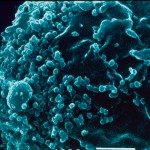Link to Pubmed [PMID] – 7512158
J. Virol. 1994 May;68(5):3041-50
Some infants infected with human immunodeficiency virus type 1 (HIV-1) rapidly develop a fatal disease characterized by a severe lymphopenia. To explain the immune dysfunction, we proposed a mechanism by which a nongeneration of CD4+ T cells is caused by HIV-1 infection of thymic cells. To examine this hypothesis, we infected primary triple-negative (TN; phenotypically CD3- CD4- CD8-), CD1a- TN, or CD1a+ TN thymic cell subsets. Our data indicate that by flow cytometry, TN, CD1a- TN, and CD1a+ TN cells remain CD4 negative throughout the culture period. We demonstrated that TN and CD1a+ TN thymic cell subsets are susceptible to HIV-1 as is the entire thymic cell population, whereas CD1a- TN cells are not. A limited number of infected TN cells are expressing HIV-1 but the level of transcription is very high in permissive cells, as detected by in situ hybridization. We then performed blocking experiments on TN cells to examine the mechanism of HIV-1 entry into these cells. CD4 (OKT4a) monoclonal antibody blocks their infection. Finally, infection experiments on two subpopulations of TN cells (CD2+ CD7+ and CD2- CD7-) indicate that infected TN cells may correspond to both immature thymocytes and thymic dendritic cells. These data are of particular interest since infection of thymic stromal cells might result in an impairment of T-cell differentiation, which may explain a nongeneration of functional CD4+ T-cell population in the thymus. This phenomenon may play a role in AIDS pathogenesis, in particular in infants born from seropositive mothers.

